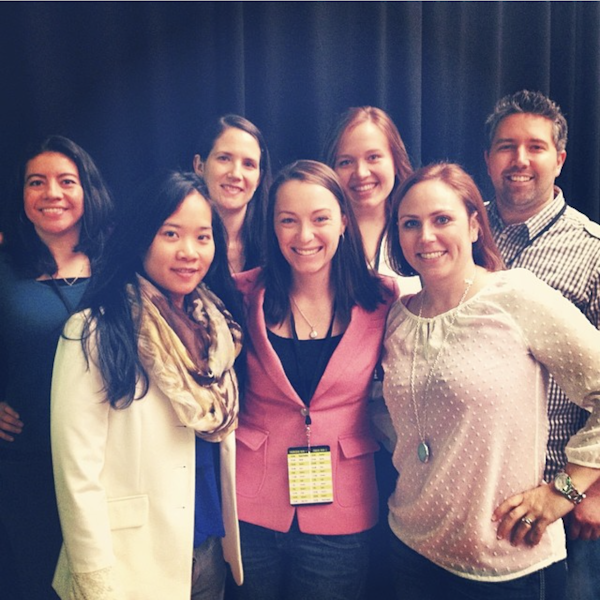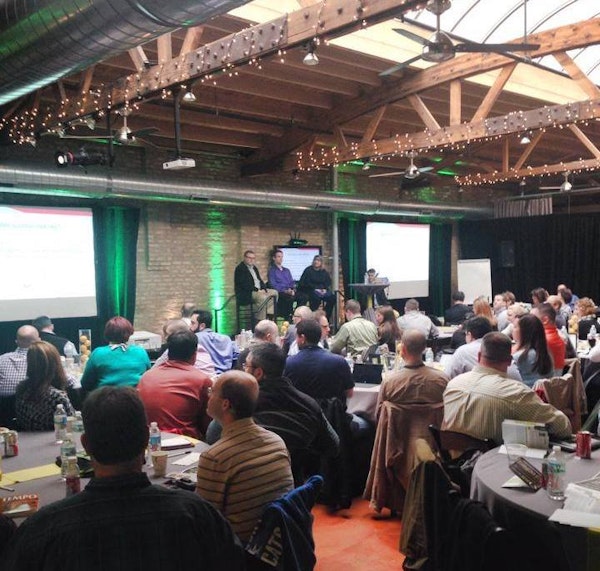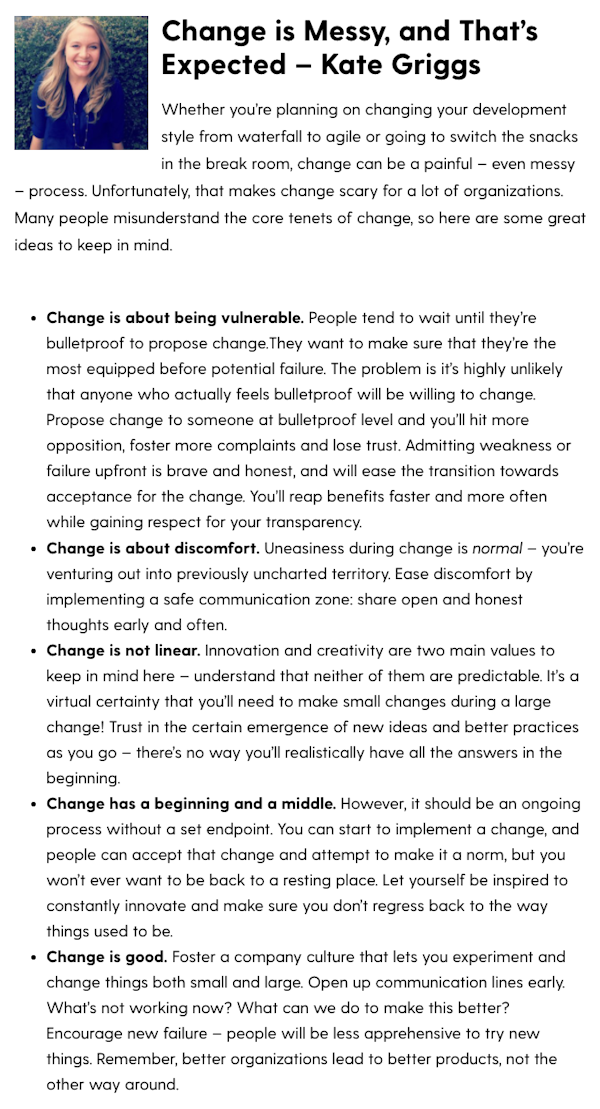Attended ALMChicago
with the Scrum Masters (or "Dev Team Coordinators" of 352 Inc.
Here's our writeup of the event: Change, Trust, and Being Truly Agile
My section copied below (and attached)
Change is Messy, and That’s Expected – Kate Griggs
Whether you’re planning on changing your development style from waterfall to agile or going to switch the snacks in the break room, change can be a painful – even messy – process. Unfortunately, that makes change scary for a lot of organizations. Many people misunderstand the core tenets of change, so here are some great ideas to keep in mind.
Change is about being vulnerable. People tend to wait until they’re bulletproof to propose change.They want to make sure that they’re the most equipped before potential failure. The problem is it’s highly unlikely that anyone who actually feels bulletproof will be willing to change. Propose change to someone at bulletproof level and you’ll hit more opposition, foster more complaints and lose trust. Admitting weakness or failure upfront is brave and honest, and will ease the transition towards acceptance for the change. You’ll reap benefits faster and more often while gaining respect for your transparency.
Change is about discomfort. Uneasiness during change is normal – you’re venturing out into previously uncharted territory. Ease discomfort by implementing a safe communication zone: share open and honest thoughts early and often.
Change is not linear. Innovation and creativity are two main values to keep in mind here – understand that neither of them are predictable. It’s a virtual certainty that you’ll need to make small changes during a large change! Trust in the certain emergence of new ideas and better practices as you go – there’s no way you’ll realistically have all the answers in the beginning.
Change has a beginning and a middle. However, it should be an ongoing process without a set endpoint. You can start to implement a change, and people can accept that change and attempt to make it a norm, but you won’t ever want to be back to a resting place. Let yourself be inspired to constantly innovate and make sure you don’t regress back to the way things used to be.
Change is good. Foster a company culture that lets you experiment and change things both small and large. Open up communication lines early. What’s not working now? What can we do to make this better? Encourage new failure – people will be less apprehensive to try new things. Remember, better organizations lead to better products, not the other way around.
with the Scrum Masters (or "Dev Team Coordinators" of 352 Inc.
Here's our writeup of the event: Change, Trust, and Being Truly Agile
My section copied below (and attached)
Change is Messy, and That’s Expected – Kate Griggs
Whether you’re planning on changing your development style from waterfall to agile or going to switch the snacks in the break room, change can be a painful – even messy – process. Unfortunately, that makes change scary for a lot of organizations. Many people misunderstand the core tenets of change, so here are some great ideas to keep in mind.
Change is about being vulnerable. People tend to wait until they’re bulletproof to propose change.They want to make sure that they’re the most equipped before potential failure. The problem is it’s highly unlikely that anyone who actually feels bulletproof will be willing to change. Propose change to someone at bulletproof level and you’ll hit more opposition, foster more complaints and lose trust. Admitting weakness or failure upfront is brave and honest, and will ease the transition towards acceptance for the change. You’ll reap benefits faster and more often while gaining respect for your transparency.
Change is about discomfort. Uneasiness during change is normal – you’re venturing out into previously uncharted territory. Ease discomfort by implementing a safe communication zone: share open and honest thoughts early and often.
Change is not linear. Innovation and creativity are two main values to keep in mind here – understand that neither of them are predictable. It’s a virtual certainty that you’ll need to make small changes during a large change! Trust in the certain emergence of new ideas and better practices as you go – there’s no way you’ll realistically have all the answers in the beginning.
Change has a beginning and a middle. However, it should be an ongoing process without a set endpoint. You can start to implement a change, and people can accept that change and attempt to make it a norm, but you won’t ever want to be back to a resting place. Let yourself be inspired to constantly innovate and make sure you don’t regress back to the way things used to be.
Change is good. Foster a company culture that lets you experiment and change things both small and large. Open up communication lines early. What’s not working now? What can we do to make this better? Encourage new failure – people will be less apprehensive to try new things. Remember, better organizations lead to better products, not the other way around.











